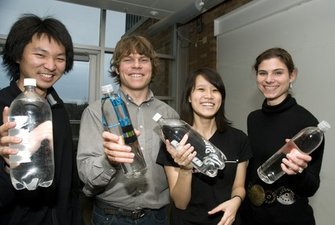
Students Chin Jung Cheng, Charlie Matlack, Penny Huang and Jacqueline Linnes designed a way to know when water left in a plastic water bottle in the sun is safe to drink.
Victims of natural disasters and those in developing countries know firsthand the importance of having clean drinking water. Purchasing, shipping, and distributing bottled water can be a costly and complicated way to secure clean water, but what if getting drinking water was as easy as setting it out in the sun? Now, thanks to a device designed by UW Engineering students, it is.
The group of students, including chemical engineering student Penny Huang and ChemE alum Chin Jung Cheng, have earned a $40,000 for winning an international contest for their design to monitor water disinfection using the sun’s rays.
In 2009, team member Jacqueline Linnes, who recently earned a Ph.D. in bioengineering, traveled to Bolivia with the UW chapter of Engineers Without Borders. While there, she and other students treated their drinking water by leaving it in plastic bottles in the sun.
Solar disinfection of water in plastic bottles, also called SODIS, removes more than 99.9 percent of bacteria and viruses, with results similar to chlorination, and offers a cheap and easy way to clean water. Adoption of SODIS has been slow, partly because it is hard to know when the water is safe to drink. The UW device lets users know when the sun’s rays have done their job.
Linnes began working on the problem with Engineers Without Borders members Chin Jung Cheng, then an undergraduate in chemical engineering and now a UW doctoral student in bioengineering, and chemical engineering senior Penny Huang.
“I have always admired the spirit of Engineers without Borders, and longed to imitate them and apply my skills for the benefit of the less fortunate,” said Huang. “I was excited to be given a chance to do exactly that and therefore became involved in the project.”
With Charlie Matlack, a UW doctoral student in electrical engineering, they built an electronic sensor system using parts from a keychain that blinks in response to light. The electronics monitor how much light is passing through the bottle and whether a water-filled bottle is present, so the system knows when to stop or start recording data. Huang focused on finding a type of solar panel that would accept the radiation range the device needs and materials for the physical placeholder of the indicator.
The competition, put on by InnoCentive Inc., with the Rockefeller Foundation supplying prize money, called for designs costing less than $10.
“We were able to assemble the indicator at the cost of 3.40 US dollars per indicator with the potential of decreasing even more costs if mass-produced,” said Huang. “We believe that those with less resources in developing nations can benefit from the use of this cost-effective instrument.”
The Sodis Foundation evaluated more than 70 proposals before choosing the UW’s. “The evaluators appreciated the fact that the [UW] device takes into consideration factors like the material of the bottle and the turbidity of the water to be disinfected,” said board member Matthias Saladin. “Other factors favoring the proposal were its robust design, the long product life and its competitive price.”
The Sodis Foundation now holds a nonexclusive license to develop the technology. It is also focusing on larger-scale systems that could be used in situations such as disaster relief. Linnes, Matlack and Tyler Davis, a doctoral student in the UW Evans School of Public Affairs, are setting up a nonprofit business to manufacture and market the device. The company's website is www.potavida.org.